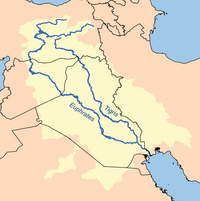
Photo from wikipedia
Major modifications regulating the Tigris River, originated in the 1940s and continuing to the present, have resulted in changes in salinity in the system over time and in different portions… Click to show full abstract
Major modifications regulating the Tigris River, originated in the 1940s and continuing to the present, have resulted in changes in salinity in the system over time and in different portions of the river course. The increase in salinity is due to decreases in stream discharge due to dams, water management structures such as the Lake Tharthar system, irrigation return flow, and soluble minerals in the basin. This research documents the increase and evaluates the causes of the salinity increase of the river from predevelopment to present using published and previously unavailable data. The predevelopment salinity was under 600 ppm, since 1984 has exceeded the 1000 ppm threshold recommended for drinking water downstream of Amara. A minimum instream flow for the river is calculated at Baghdad and Kut at 185 cubic meters per second (cms), approximately 15% of the mean historical flow of the river, but above the lowest minimum flow recorded at 140 cms. Recommended salinity management options discussed include (1) eliminating Lake Tharthar as a water storage facility, (2) managing saline inflows from tributaries, and (3) employing a minimum instream flow for the river.
Journal Title: Regional Environmental Change
Year Published: 2018
Link to full text (if available)
Share on Social Media: Sign Up to like & get
recommendations!